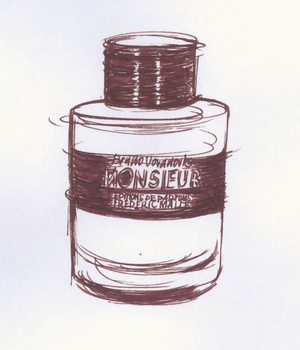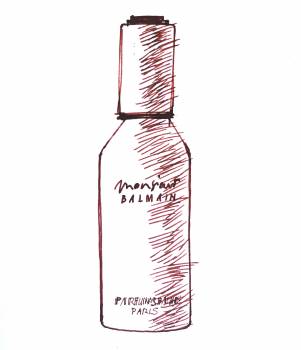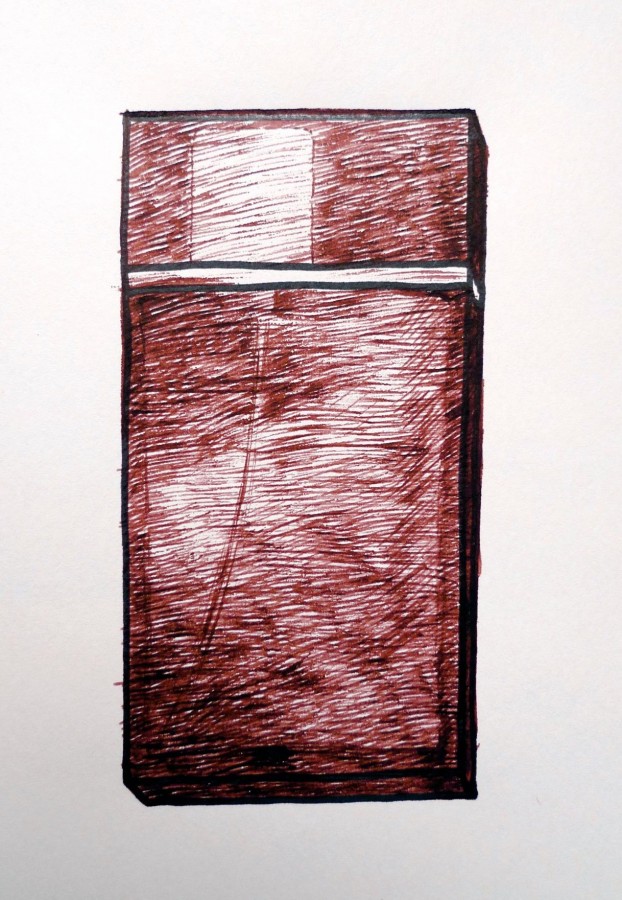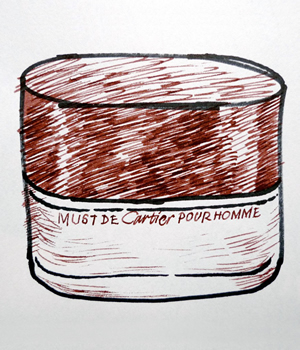Article Archive
Heeley
Menthe Fraîche
31 March, 2017
The mouth-watering smell of mint might be one of the most refreshing scents in the natural world, but it’s a bugger to use in perfumery, for the simple fact that toothpaste manufacturers got there first. Mint has been the most popular flavour for toothpaste since the early 20th century, so it’s a brave perfumer who decides to make it the main ingredient in a scent.
Enter the Yorkshire-born, Paris-based scentorialist James Heeley, who in 2004 released Menthe Fraîche, a bold and rather brilliant fragrance that puts mint firmly on centre stage – and got away with it without making it smell like mouthwash.
Menthe Fraîche smells fantastically minty by dint of a clever combination of natural and synthetic ingredients that reinforce and support each other in a way that simply spraying mint-oil on yourself never would. James Heeley notes that ‘Menthe Fraîche was a collaboration with a laboratory in Grasse, inspired by the smell of Corscian mint underfoot. It includes bergamot, a lot of cedarwood, fir balsam and white musk. It’s fresh without being overpoweringly minty.’ It includes both spearmint and the colder-smelling peppermint, as well as hints of green tea.
Though sadly it doesn’t last very long on the skin, Menthe Fraîche does keep going longer than some reviewers have claimed; I can still smell it a couple of hours after spraying it on, but then it’s a pleasure to reapply. And it is, after all, a cologne, something you’d use to freshen up on a hot summer’s day, rather than the kind of heavyweight perfume you might long for on a cold winter evening.
Created in collaboration with the professional perfumer David Maruitte, it also has a raft of synthetics, detailed by Chandler Burr in a typically excellent article for the New York Times, which you can read here. In a variation on the theme of art concealing art, Menthe Fraîche smells so wonderfully fresh and natural precisely because of the synthetic molecules in its make-up, not despite them – and that for me is one of the wonders of professional perfumery.
Frédéric Malle
Monsieur.
1 November, 2016
 Monsieur. (aka Monsieur Dot) has divided opinion among my friends. Reactions have ranged from ‘cough mixture’ and ‘Vicks VapoRub’ to ‘virile’ and ‘chest wig’. Malle himself describes it as ‘super manly, very polished, though not affected’ and as having ‘a natural masculine elegance.’
Monsieur. (aka Monsieur Dot) has divided opinion among my friends. Reactions have ranged from ‘cough mixture’ and ‘Vicks VapoRub’ to ‘virile’ and ‘chest wig’. Malle himself describes it as ‘super manly, very polished, though not affected’ and as having ‘a natural masculine elegance.’
Created by the French perfumer Bruno Jovanovich, Monsieur. is a disco anthem to the 1970s playboy, all bay rum and alcohol with a whiff of cigarette smoke thrown in – think George Best meets Gianni Agnelli.
It’s based around patchouli, that all-too-popular scent of the time, but rather than the sweet, dope-addled patchouli of Camden Market hippy shops, this patchouli is raspy and slightly grubby round the edges, reminding us that it’s derived from an Indian roadside weed.
According to Malle, patchouli accounts for half of Jovanovich’s formula, but there’s also an odd mix of sweet and bitter ingredients, including mandarin orange and bay rum. The formula also includes synthetic amber and musk for longevity and plushness, with cedar, frankincense and vanilla adding extra smokiness and depth. ‘Bruno showed the appetite of a young perfumer,’ Malle says. ‘He wanted to work on a classic and to compare himself with the other star perfumers I’ve been working with. That being said, he proved that he is already super mature when it comes to finishing such a hard product to make.’
If you like old-fashioned masculine smells and rum then Monsieur Dot is probably for you; if not you might find its bitter patchouli a bit too punchy for your taste, though Malle is unrepentant. Asked whether he thinks that men are re-embracing a more traditional form of masculinity, he proffers a very Gallic reply. ‘We live in a kaleidoscope full of different characters – a sort of “à la carte” world. There must be traditional, no bullshit, traditional elegance out there.’
As for its intriguing name, Malle explains that his idea was for a perfume, in his words, ‘Designed for a real Monsieur with no extra thrills or necessary embellishment, hence the “.”’ I get his point.
Balmain
Monsieur Balmain
25 May, 2015
 Lemon verbena is not, it has to be said, the most beautiful shrub in the world, though it’s easy enough to grow in a sunny corner. Its long woody stems give it a rather ungainly appearance, with tufts of spear-shaped leaves at their ends, which appear so late in the season that I’ve often wondered whether the one in my garden was dead.
Lemon verbena is not, it has to be said, the most beautiful shrub in the world, though it’s easy enough to grow in a sunny corner. Its long woody stems give it a rather ungainly appearance, with tufts of spear-shaped leaves at their ends, which appear so late in the season that I’ve often wondered whether the one in my garden was dead.
Aloysia citrodora, to give it its Latin name, grows wild across much of South America, and like so many other garden plants it was brought to Europe by Portuguese and Spanish colonists at some point in the seventeenth century.
Though you wouldn’t grow lemon verbena for its shape, its leaves are a different matter. Long, narrow and folded neatly in half along their length, they are bright green, shiny, and rather rough and sticky to the touch. But what makes them special is the scent they release when crushed, which is so deliriously refreshing that, once I’ve started sniffing them, I find it extremely hard to stop. They make a fine herbal tea (the verveine in which Proust dipped his famous madeleine) and an even finer perfume.
As both its common and Latin names suggest, lemon verbena has a lemony scent – yet that hardly does it justice. Lemons may have a wonderfully fresh, sharp tanginess of their own, but it’s accompanied by the sour, mouth-puckering sharpness of their taste. Lemon verbena has none of that. It has all the freshness of lemon, for sure, but mixed with a gentle sweetness that never becomes cloying, however often you smell it.
This sherbety, sorbet-y scent has all the innocence of childhood: just smelling it can give me the giggles. It might not be the most sophisticated fragrance in the world, but I can think of few better pick-me-ups on a dull dark morning, or for that matter on a sultry summer’s day. And what I love about Monsieur Balmain is that it smells pretty much exactly like lemon verbena, with little else to distract your attention – and why would you want to have your attention distracted from such a delicious scent?
Perfume buffs will already know that Monsieur Balmain was originally created by Germaine Cellier, who was the perfumer behind such justly famous fragrances as Fracas, Bandit, Vent Vert and Jolie Madame. Cellier died in 1976, and Monsieur Balmain was relaunched in 1991 in a new – but apparently faithful – reformulation by Calice Becker, the creator of (among many others) Tommy Girl and Dior’s J’Adore. More recently its bottle has also been redesigned, which means that my illustration is already out of date. For once, though, the new design is classier than the old one, so all respect to Balmain (or rather to Inter Parfums, the company that recently bought Balmain’s perfume licence).
Cartier
Must de Cartier
14 October, 2013
I love this perfume, though Cartier have foolishly discontinued it – not only because it’s such an alluringly unusual smell for a man, but also because both perfume and bottle have the feel of solid quality about them, which is more than can be said for a lot of big-brand fragrances.
Must de Cartier pour homme was created by perfumer Nathalie Feisthauer from Symrise, the German-based fragrance multinational, and launched in 2000, but it’s remained relatively little known despite its quality.
To me it has a soft, almost floral smell without being particularly feminine – slightly rose-like, perhaps, but in the delicate a-rose-is-not-a-rose manner of old-fashioned tea roses derived from the wild Rosa odorata. It’s gentle, too, warm without being heavy; in fact the lightness of its warmth is its Achilles heel, as the one thing it really lacks is much staying-power.
The word that crops up most often in reviews is ‘refined’, and I’ll happily second that. Like Chanel’s Pour Monsieur it’s not a statement perfume; that is, it’s not something to spray on if you want other people to notice it, at least consciously. But you’ll still smell mighty fine, even if only someone very close to you is likely to pick up on it.
Maybe it’s just my lack of olfactory sophistication, but Must de Cartier is one of those odd perfumes that – to me at least – smells unlike any of its actual ingredients, which include sandalwood, bergamot, mandarin, anise and tonka bean. That may, of course, be a testament to the skill with which Nathalie Feisthauer blended them together, though when I asked a friend to sniff it they instantly said ‘liquorice’, which I guess must be the anise.
Still, that leaves the question of what Must de Cartier does actually smell like, and I’m still puzzling over that. It has a certain warmth and sweetness, which presumably derives from the sandalwood and tonka bean, but my rose associations may – oddly – be an olfactory red herring, suggested by the Cartier deep-rose red of the chunky bottle top.
It’s a rare fragrance that can be unusual without being weird, elegant without being boring, and distinctive without being overpowering: if only it was still on the shelves.
Yves Saint Laurent
M7
12 July, 2012
 Tom Ford’s relatively short tenure at Yves Saint Laurent, from 2000 to 2004, won him both fans and detractors – among them YSL himself, who used to pen helpful letters criticising Ford’s latest shows. But it was Ford’s own considerable design talents and his genius for publicity dragged the declining fashion house back into the limelight, no more so than with the launch of M7 in 2002.
Tom Ford’s relatively short tenure at Yves Saint Laurent, from 2000 to 2004, won him both fans and detractors – among them YSL himself, who used to pen helpful letters criticising Ford’s latest shows. But it was Ford’s own considerable design talents and his genius for publicity dragged the declining fashion house back into the limelight, no more so than with the launch of M7 in 2002.
In a nod to Jeanloup Sieff’s legendary 1971 photograph of a naked Yves Saint Laurent that was used to promote the first YSL men’s fragrance, Ford launched M7 in 2002 with a full-frontal nude of martial-arts star Samuel de Cubber shot by Swedish photographer Sølve Sundsbø.
The all-too predictable storm of controversy may have long since been left behind, and sadly the perfume has since been reformulated and dumbed down, which is a real shame as it was originally an unusual and (to me at least) extremely appealing scent.
Tom Ford’s influence is most obviously apparent with the original bottle (pictured), which was a crisply designed rectangle of brown glass, the colour of medicine bottles. The brown perspex cap clipped on with a satisfying clunk, and the spray mechanism was set two-thirds along the top, giving it a cool asymmetric outline which has ‘designer’ written all over it. (Not literally – keep up!) It’s since been redesigned and the perfume reformulated, which is sadly typical of the industry.
What makes the perfume itself immediately striking is its odd yet somehow very successful combination of fruity sweetness with the almost catch-in-the-throat smell of woodsmoke, which gives it a masculine edge it would otherwise lack. Not very noticeable is an initial burst of citrus provided by bergamot and mandarin, though that probably adds something to that first impression of fruitiness.
What I hadn’t realised was that perfumers Alberto Morillas and Jacques Cavallier also added a touch of rosemary to the mix. It’s not something that jumps out at you, but smelling it again I twigged, for the first time, that rosemary’s herby smell has something a bit smoky about it too.
It’s a very clever way to emphasise this fragrance’s appealing smokiness, whose dryness is also underlined by a touch of that ultimate in male-perfume ingredients, the bitter earthy smell of vetiver. M7 lasts well too, and if some people find it either too fruity or slightly medicinal, then let them; I really don’t care.
